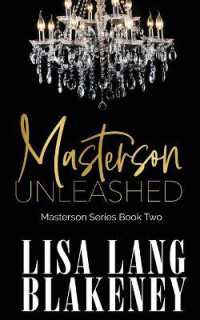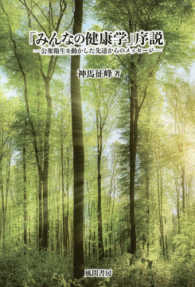- ホーム
- > 洋書
- > 英文書
- > Literary Criticism
Full Description
The discovery of the Rosetta Stone and the subsequent decipherment of Egyptian hieroglyphics captured the imaginations of nineteenth-century American writers and provided a focal point for their speculations on the relationships between sign, symbol, language, and meaning. Through fresh readings of classic works by Emerson, Thoreau, Whitman, Poe, Hawthorne, and Melville, John T. Irwin's American Hieroglyphics examines the symbolic mode associated with the pictographs. Irwin demonstrates how American Symbolist literature of the period was motivated by what he calls "hieroglyphic doubling," the use of pictographic expression as a medium of both expression and interpretation. Along the way, he touches upon a wide range of topics that fascinated people of the day, including the journey to the source of the Nile and ideas about the origin of language.
Contents
Preface
Part I: Emerson, Thoreau, and Whitman
Chapter 1. Champollion and the Historical Background; Emerson's Hieroglyphical Emblems
Chapter 2. Thoreau: The Single, Basic Form — Patenting a Leaf
Chapter 3. Whitman: Hieroglyphic Bibles and Phallic Songs
Part II: Poe
Chapter 4. The Hieroglyphics and the Quest for Origins: The Myth of Hieroglyphic Doubling
Chapter 5. Ends and Origins: The Voyage to the Polar Abyss and the Journey to the Source of the Nile; The Survival of the Manuscript
Chapter 6. Certainty and Credibility — Self-Evidence and Self-Reference; Nietzsche and Tragedy — Whitman and Opera; The Open Road
Chapter 7. Writing Self / Written Self; The Dark Double; The Overwhelming of the Vessel
Chapter 8. Cannibalism and Sacrifice; Metaphors of the Body — Transfiguration, Transubstantiation, Resurrection, and Ascension
Chapter 9. Narcissus and the Illusion of Depth
Chapter 10. Self-Recognition; Deciphering a Mnemic Inscription; Historical Amnesia and Personal Anamnesis
Chapter 11. Repetition; Symbolic Death and Rebirth; The Infinite and Indefinite; The Mechanism of Foreshadowing
Chapter 12. The Unfinished Narrative; The Cavern Inscription on Tsalal; Survival in an Image
Chapter 13. The White Shadow; Imaging the Indefinite; Reading the Spirit from the Letter; The Finality of Revenge; The Alogical Status of the Self
Chapter 14. The Return to Oneness; Breaking the Crypt; The Limits of Interpretation; The Ultimate Certainty
Part III: Hawthorne and Melville
Chapter 15. Hawthorne: The Ambiguity of the Hieroglyphics; The Unstable Self and Its Roles; Mirror Image and Phonetic Veil; The Feminine Role of the Artist; Veil and Phallus; The Book as Partial Object
Chapter 16. Melville: The Indeterminate Ground; A Conjunction of Fountain and Vortex; The Myth of Isis and Osiris; Master Oppositions; The Doubleness of the Self and the Illusion of Consistent Character; Dionysus and Apollo; Mask and Phallus; The Chain of Partial Objects
Epilogue
Notes
Index








